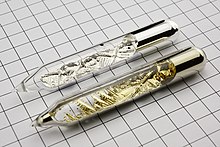Wikipedia:Reference desk/Archives/Science/2024 August 18
| Science desk | ||
|---|---|---|
| < August 17 | << Jul | August | Sep >> | August 19 > |
| Welcome to the Wikipedia Science Reference Desk Archives |
|---|
| The page you are currently viewing is a transcluded archive page. While you can leave answers for any questions shown below, please ask new questions on one of the current reference desk pages. |
August 18
[edit]Colour of francium
[edit]Is francium predicted to have a colour other than silverish, just like caesium above? Nucleus hydro elemon (talk) 13:17, 18 August 2024 (UTC)

- Cs is a bit yellow because its plasma wavelength is in the very near ultraviolet: here it is calculated as 351 nm. In francium we cite Arblaster for the lattice parameter and crystal structure for Fr; he extrapolates them from the trend, and that would suggest a higher wavelength for Fr, and consequently a more yellow colour than Cs.
- However, per Covalent radius#Radius for multiple bonds, relativistic effects may make Fr atoms slightly smaller than Cs atoms, not bigger. Since such a relativistic prediction has been experimentally validated for the ionisation energy of Fr, I am inclined to think that this should be correct, and that extrapolation for Fr will give the wrong answer. If that's so, the plasma wavelength of Fr should be between those of Cs and Rb, and as a result, it could at most be very pale yellow – closer to silvery than Cs. At least, Droog Andrey (a computational chemist) also answered this way when I asked him back in 2018.
- There's of course an obligatory disclaimer here that any macroscopic sample of Fr would vapourise itself immediately, leaving you with bigger problems than worrying about its colour. But it's a fun question indeed! :D Double sharp (talk) 09:21, 19 August 2024 (UTC)
- Thanks, the properties of Po~Ac are really interesting! It's pity to see them die in extreme radioactivity. By the way, both Po2+ (pink) and Po4+ (yellow) are coloured. Ignoring that large amounts of At will immediately boil the solution, will similar things happen in astatine cations At+ and AtO+, making them coloured? Nucleus hydro elemon (talk) 11:01, 19 August 2024 (UTC)
- I think it's not possible to answer this because the structures of the At aqueous ions are not really known (and AFAIK there are not yet predictions). Famously, unhydrolysed [Fe(H2O)6]3+ has a quite different colour from its hydrolysis products.
- I also wish Po~Ac were more stable: they'd be superbly interesting to study. In particular, I'd like to know how the chemistry of Rn compares with that of Xe, and if it might be possible for Fr to break into the 6p shell. But if we go that far, then why stop there? Copernicium would be amazing to study. (Though I guess its compounds would be pretty toxic. It must be a very soft cation indeed.) :) Double sharp (talk) 14:03, 19 August 2024 (UTC)
- I just start to think an alternative universe where these elements (possibly Tc and Pm too) are more stable. That universe might found more interesting properties, which we can't due to their extreme radioactivity. :) Nucleus hydro elemon (talk) 15:01, 19 August 2024 (UTC)
- Thanks, the properties of Po~Ac are really interesting! It's pity to see them die in extreme radioactivity. By the way, both Po2+ (pink) and Po4+ (yellow) are coloured. Ignoring that large amounts of At will immediately boil the solution, will similar things happen in astatine cations At+ and AtO+, making them coloured? Nucleus hydro elemon (talk) 11:01, 19 August 2024 (UTC)
Dextrin and wetting
[edit]On the Joseph Lister article it now mentions this oiled green silk used as a wound dressing that has been painted one side with dextrin to ensure a thorough wetting with carbolic acid to steralize it. What is actually happening here? Why would it be painted on one side with dextrin. There does seems to a lot of references when you search dextrin and wetting, even in the modern context, but what does it mean exactly? It is an oiled silk dressing from 1865, sold under the brand "Oiled Green Silk Protective". There is several images of it. scope_creepTalk 20:27, 18 August 2024 (UTC)
Silk is hydrophobic (not rabies) - water on silk beads up rather than soaking in. The powder (dextrin would be used because it is fine and easily available) would absorb the acid and allow it to permeate the silk. Or so my natural dyeing wife tells me. Greglocock (talk) 04:23, 19 August 2024 (UTC)
- @Greglocock: Right. That is really cool. That makes sense, finally. Yipeeee. I will make a note to that effect. I now need to find a reference to support it but should be easier now there is an explanation. I didn't think that was going to answered. That is excellent. Give yourself and your wife a gold star. I'm happy. The simple things in life.:) scope_creepTalk 11:17, 19 August 2024 (UTC)
